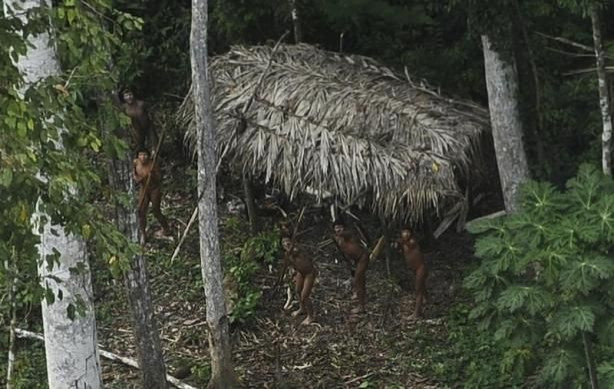Isolated Amazon Tribe In Brazil Makes Contact With Outsiders In New Video

Members of an isolated Amazonian tribe have made contact with outsiders for the first time, and the extremely rare encounter was caught on video. In the footage, released Tuesday by Brazil’s National Indian Foundation, or FUNAI, seven loincloth-clad people carrying bows and arrows emerge from the Amazon rainforest and accept banana bunches from a member of Brazil’s Asháninka Indians, an indigenous group that lives along the border of Peru and Brazil.
The tribespeople first emerged from the dense jungle on June 27, according to local sources, after which the members of the Asháninka settlement radioed Brazilian authorities. A specialist team of scientists from Brazil’s government was flown in to make contact with the tribe. The video was filmed June 30 during a second encounter with the tribespeople and shows the moment an Asháninka man wearing basketball shorts approaches two of the tribesmen and hands them bananas. The tribesmen appear hesitant, and quickly back away after taking the fruit.
According to officials, there are at least 70 isolated tribes in living in the Brazilian Amazon. Several other tribes are scattered across other parts of the Amazon basin. Many of these tribes have made contact with outsiders before, but this is the first time Brazilian officials have directly encountered an isolated tribe in 18 years. The last official contact took place in October 1996 when a small group of Korubo Indians met with FUNAI officials after months of watching and waiting.
The natives seen in the video, who experts say belong to the Panoan language group, a family of languages spoken in Peru, western Brazil and Bolivia, crossed into Brazil from Peru in late June after logging and conflict with drug traffickers drove them from their home, the Los Angeles Times reports. Officials believe illegal loggers could have driven off the animals the tribe hunted, forcing them to move elsewhere.
“Something serious must have happened,” José Carlos Meirelles, a former official with FUNAI, said of the encounter, according to Survival International. “It is not normal for such a large group of uncontacted Indians to approach in this way. This is a completely new and worrying situation.”
Leaders of the Asháninka have asked the Brazilian government to control what they consider the encroachment of these tribes on their own land. One scene in the video shows the natives taking axes and other supplies from the Asháninka village. "This is a people looking for technology,” anthropologist Terri Aquino told The Telegraph. “It's important in their lives because there's an internal war among them and because of contact with non-indigenous groups.”
Shortly after the recent encounter occurred, all seven of the natives – five men and two women – became sick with the flu. Newser reports that the tribespeople agreed to letting scientists treat them with medicine. The natives were given flu shots before they returned to the jungle, but officials fear they may have brought the disease to their village and spread it to other tribe members, all of whom lack natural immunity to the illness. It is unclear whether the natives contracted the flu virus from their encounter with the Brazilian scientists, or from villagers they had recently raided for tools and food.
Exposure to European diseases killed untold millions of the Western Hemisphere's population after Columbus landed in 1492.
FUNAI has often released aerial photos of “lost” Brazilian tribes to draw awareness to the dangers of illegal logging. The group has even launched a petition to the Brazilian and Peruvian governments to “protect all uncontacted Indians land as a matter of urgency.”
“If your governments do not act quickly,” the petition reads, “the lives of some of the last uncontacted Indians on the planet will be destroyed forever.” Many of the “uncontacted” tribes, however, have encountered outsiders before, but do not maintain regular contact.
© Copyright IBTimes 2024. All rights reserved.






















